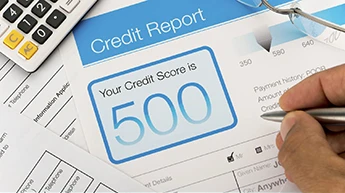A 500 Credit Score Loan: Your Guide to Success

Taking out a loan with a 500 credit score can be difficult but possible. Although you can get a higher interest rate, there are several options to help you manage your urgent money needs with bad credit. Let’s discuss what 500 credit score loans are available and how you can get one. We’ll also find out how to get a better loan deal with poor credit and consider practical ways to increase your credit score.
Table of Contents
- What is a 500 Credit Score?
- How Do Lenders for Bad Credit Work?
- Myth Busting Facts
- Types of Loans Available for a 500 Credit Score
- How Can I Borrow Money with a 500 Credit Score?
- Ways to Improve Your Chances of Loan Approval with Bad Credit
- Bottom Line: What to Do Next?
- Expert Tips & Advice
What is a 500 Credit Score?
According to the FICO score system, credit scores vary between 300 and 850. A credit score of 500 is considered a very poor credit rating. It shows you have had issues handling your debt or bills.
Below are some of the causes of a low credit score:
- Bad payment history. The inability to make on-time payments on your loans or credit card bills may knock up to 100 points off your credit rating.
- High credit utilization ratio. The closer your outstanding balance gets to your credit limit, the more risk you pose as a borrower, which reduces your FICO rating.
- Limited credit history. A short credit history may influence your credit score as bureaus has limited information to assess your financial behavior.
- Too many new credit accounts opened. Opening several credit accounts within a short period may be considered a sign of financial difficulties, which makes you a risky borrower. Additionally, each new personal loan application reduces your credit score by about 5 points.
- Lean credit mix. Credit bureaus want to see you can manage different credit accounts. Having only one type of debt on your credit report can be harmful for your FICO score.
As a result, a credit score of 500 makes it difficult to be approved for a loan and get reasonable borrowing terms. Loan providers consider a low score an indication of a high probability of loan default. Most traditional lenders will only offer you a loan for bad credit of 500 with a guarantor or collateral.
How Do Lenders for Bad Credit Work?
Specialized lenders who work with bad credit borrowers have a simple working process. Here are their main features:
More lenient requirements on creditworthiness. Alternative lenders are more flexible about who they approve. If you have a steady income, they can deal with you regardless of your less-than-perfect score. No credit check. Loan providers who work with bad credit borrowers usually don’t run hard credit inquiries. This simplifies and speeds up the entire process while leaving your credit score unchanged. Small loan amounts. Bad credit loans usually come with lower borrowing limits to prevent you from falling behind on payments. Shorter repayment periods. If you borrow money with poor credit, you’ll likely get a shorter loan term, too. The monthly payments will be higher, but you pay off the debt faster. High APRs. Bad credit lenders tend to charge higher interest rates to offset the risks associated with a high probability of not getting their money back. For some loan options, APRs may exceed 400%. Additional fees. Some direct lenders tack on extra charges, such as origination fees or early repayment penalties. Ensure to read the fine print so you know what you’re getting into.
Myth Busting Facts
There are some myths regarding bad credit and low credit score loan options. Let’s clear some things out to avoid misconception.
Myth 1: “You cannot get a loan when your credit score is low”.
Reality: Although receiving loan approval with bad credit may be difficult, different bad credit lenders offer financial products for borrowers with less-than-ideal scores. In such cases, higher interest rates or a lower borrowing limit typically apply.
Myth 2: Bad credit loans are characterized by very high interest rates.
Reality: The rates on bad credit loans are only sometimes pricey. APRs differ from one loan provider to another and depend on multiple factors, including your income, state, the ability to provide a cosigner or repayment guarantee, and others.
Myth 3: Applying for a bad credit loan will further damage your credit score.
Reality: Most online or alternative lenders don’t check your credit score through the major credit bureaus during the loan application process. On the one hand, the on-time payments on these loans won’t improve your credit score. On the other hand, your FICO rating won’t drop as long as you pay on time.
Types of Loans Available for a 500 Credit Score
There are both long-term and short-term loans for a 500 credit score you can access. Here’s a simple breakdown of the most commonly used options:
Installment loans for a 500 credit score. These loans allow you to borrow up to $5,000 and repay the funds in equal monthly installments over 2 to 24 months. They don’t require collateral, meaning that you don’t risk losing your property in case of loan default. Interest rates usually range from 16% to 200%. Title loans. A title loan requires collateral, such as your car title. The lender provides you with a portion of your vehicle’s cost and allows you to drive the car during the repayment period, which is usually 30 to 60 days. Interest rats may be up to 300%, and you can lose your car if you default. Credit-builder loans. These loans aim to improve your credit score by making fixed monthly payments upfront without getting the borrowed amount on hand. Each on-time payment is reported to the major credit bureaus. Once the repayment period ends, you get access to your loan funds. Emergency loans for a 500 credit score. Also known as payday loans, these borrowing options provide quick assistance till a borrower’s next paycheck. You can borrow up to $1,000 and repay it in 7, 14, or 31 days. However, they are accompanied with high APRs, often exceeding 395%. Co-signed loans. Co-signed options allow you toapply with a person who has a good credit score and steady income to secure your loan if you fail to repay the money on time. This makes it possible to get more favorable loan terms. Payday alternative loans. Some credit unions offer these loans with more convenient terms and conditions than regular payday loans. The repayment schedule stretches for up to six months. The maximum annual percentage rate is 28%, and the maximum amount you can borrow is $2,000.
How Can I Borrow Money with a 500 Credit Score?
The best way to borrow money with credit issues is to find the right lender and apply for online loans for a 500 credit score. Here are some steps to take:
- Check your credit score. Get free copies of your credit reports from each of the three major credit bureaus to better understand your options. Check the information in the documents for errors and dispute inaccuracies, if any.
- Choose the right lender. Do your research and find loan providers with the requirements you can meet. Also, pay attention to their advertised interest rates and terms and choose several offers with reasonable conditions.
- Gather the required documents and information. You will typically need to provide proof of income, employment, and address, as well as your SSN, identification, and bank account details.
- Pre-qualify. Fill out a prequalification form from several loan providers to get their potential offers and choose the lender with the best possible terms. This step won’t affect your credit.
- Complete the final application. Provide the required documents with the chosen lender and wait for a loan decision. Make sure you understand the verification procedure. Some lenders may perform a hard credit check at this stage.
- Receive the funds. If approved, read and e-sign the loan agreement. Then, you will get the money via a direct deposit within 1 to 3 business days.

Ways to Improve Your Chances of Loan Approval with Bad Credit
Bad credit can make it difficult to qualify for favorable loan terms. Here are some ways to boost your approval chances:
- Get a secured loan. Collateral backing offsets the lender’s risk, making them more willing to approve your for a loan due to the repayment guarantee provided.
- Apply with a co-signer. Rely on a person with a better credit score and stable financial situation. It will help you get a positive approval decision.
- Demonstrate a steady income. Money matters are second in importance when it comes to your creditworthiness. If you have a high and stable income, you’re likely to qualify for a loan, even with bad credit. Alternative income sources, such as self-employment, investment, and benefits, may also be accepted.
- Pay off your existing debts. The less of your income goes toward paying off your current debts, the better. Aim for a debt-to-income ratio of no more than 43%.
- Improve your FICO score. While people with bad credit still can access various loan options, boosting your credit score can unlock better borrowing opportunities at more favorable terms. Pay your loans and bills on time, reduce your credit utilization, or get a secured credit card or a credit-builder loan for better results.
Bottom Line: What to Do Next?
While there are various loan options to turn to with a credit score of 500, your FICO rating influences your loan terms and conditions. Think about improving your credit situation before applying. The 15M Finance team advises you to monitor your credit report for possible mistakes and do basic things, such as paying off outstanding balances, making on-time loan and bill payments, and avoid applying for new loans too frequently. Use online services to look for the best loan products, discuss your options with financial planners, and get financial assistance for bad credit from credit counselors, if necessary.
Expert Tips & Advice
Start your credit score improvement with small steps, such as paying bills on time and decreasing your credit utilization ratio. Increase your monthly income by starting side gigs or a small start-up to add extra dollars to your budget. Pay off high-interest debt. It means covering payday loan debt, credit card balances, or other high-interest loans.
See also:
Resources:
